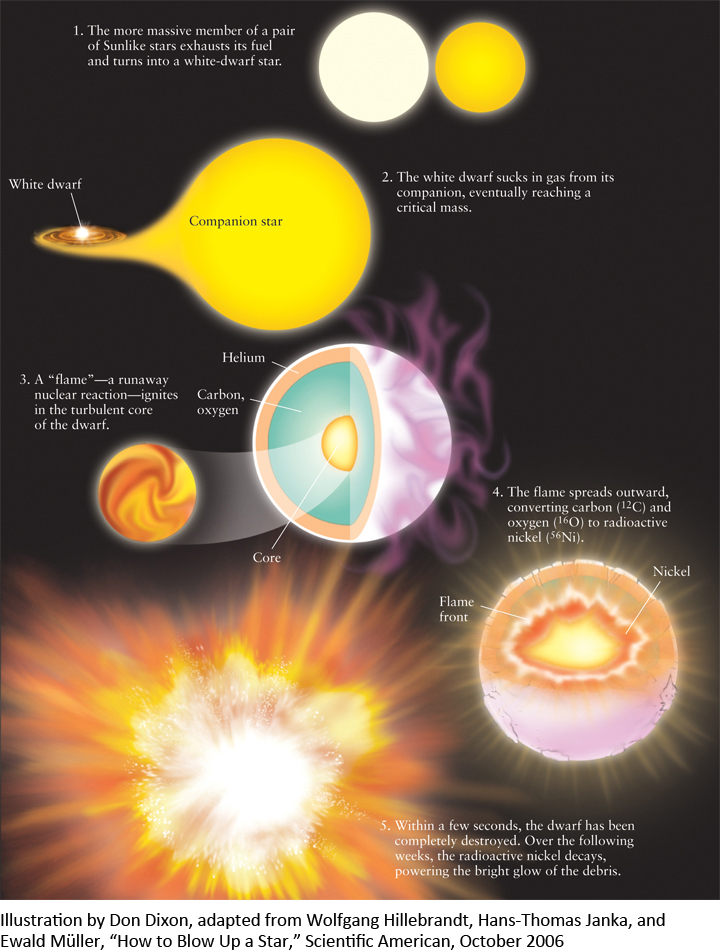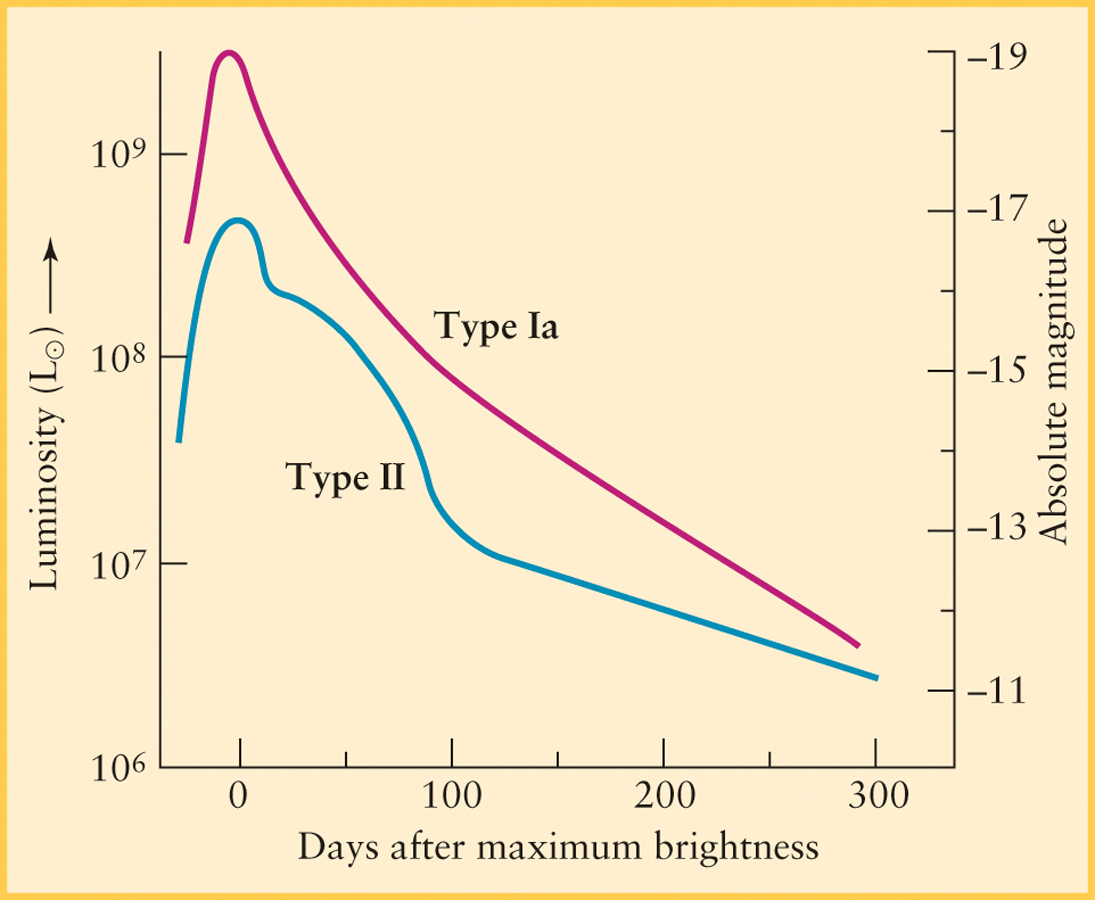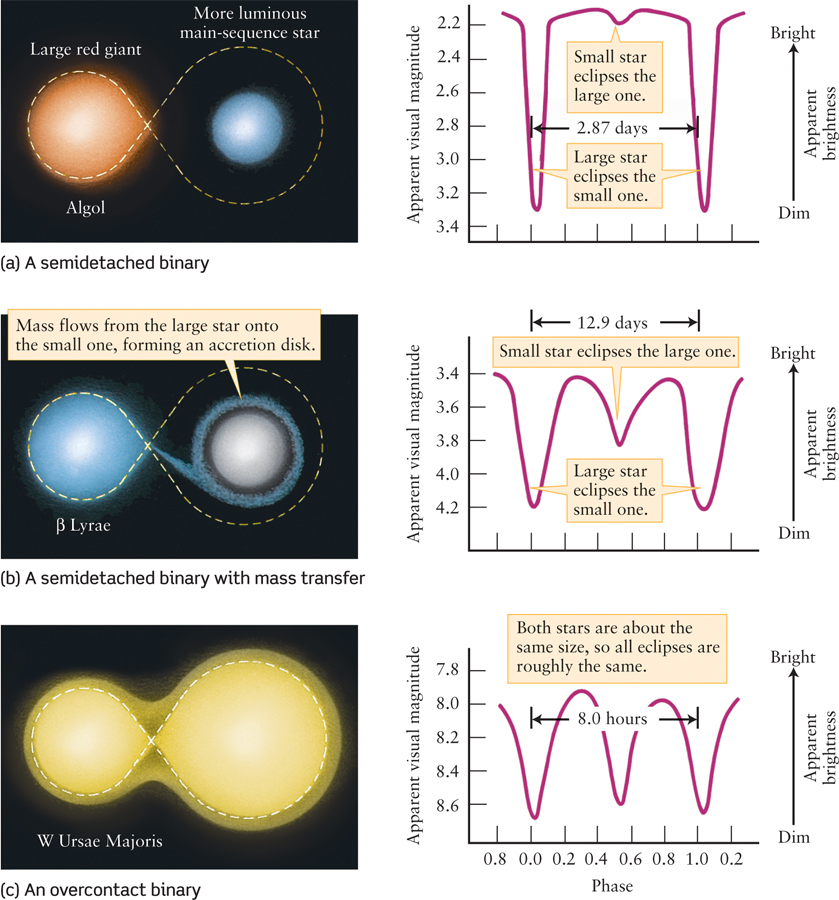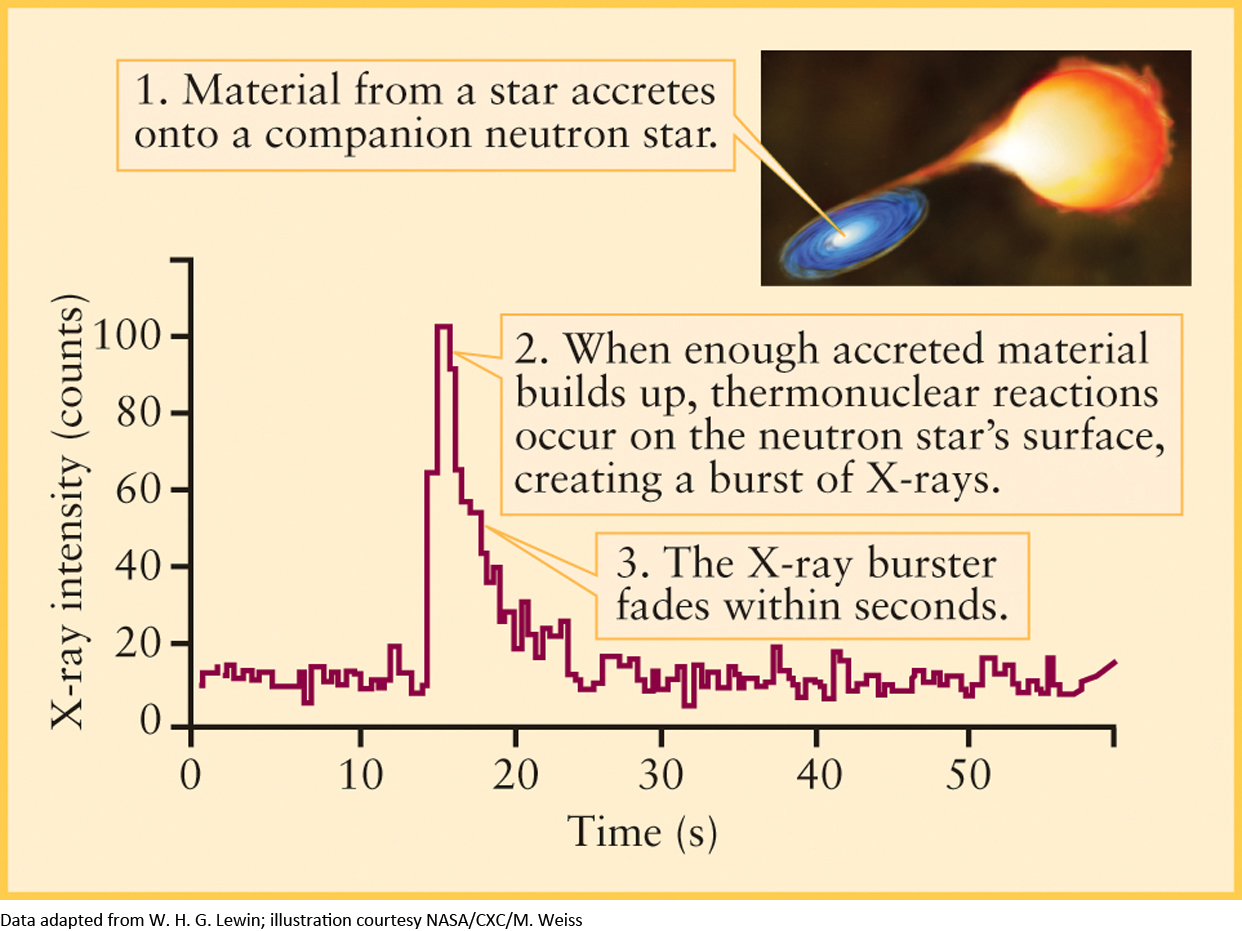12-5 White dwarfs and pulsars in close binary systems can become novae, bursters, and supernovae
 Go to Video 12-5
Go to Video 12-5
Black holes are indeed fantastic objects. Even stranger, other exotic phenomena can occur when a stellar corpse is part of a gravitationally bound binary star system. One example is a nova (plural novae), in which a faint star suddenly brightens by a factor of 104 to 108 over a few days or hours, reaching a peak luminosity of about 105 L⊙. By contrast, a supernova has a peak luminosity of about 109 L⊙.
A nova’s abrupt rise in brightness is followed by a gradual decline that may stretch out over several months or more. Every year, two or three novae are observed to flare up in our Galaxy, and several dozen more are thought to take place in remote regions of the Galaxy that are obscured from our view by interstellar dust.
Type Ia Supernovae: Detonating a White Dwarf
A supernova is not just a bright nova; they are formed entirely differently.
We need to take a step back from novae for a moment and talk about supernovae. Supernovae that are caused by a core collapse of a massive star of the sort we described earlier are best described as Type II supernovae. They are caused by the death of highly evolved massive stars that still have ample hydrogen in their atmospheres when they explode. When the star explodes, the hydrogen atoms are excited and glow prominently, producing hydrogen emission lines. SN 1987A is an example of Type II supernovae.
If there are Type II supernovae, that must mean that there is another category of exploding stars. The other type has no hydrogen lines in the spectrum. This category is called Type I supernova. Type I supernovae are further divided into three important subclasses, Type Ia, Ib, and Ic. Although the others are interesting, we are going to focus exclusively on supernovae Type Ia, because it is the most relevant in developing our understanding of the size and structure of our universe.
Type Ia supernovae are thought to result from the thermonuclear explosion of a white-dwarf star. This may sound contradictory, because we saw in Chapter 11 that white-dwarf stars have no thermonuclear reactions going on in their interiors. But these reactions can occur if a carbon-oxygen–rich white dwarf is in a close, semidetached binary system with a red-giant star.
Figure 12-17 shows the likely series of events that leads to a Type Ia supernova. Stage 1 in this figure shows a close binary system in which both stars have less than 4 M⊙. The more massive star on the left evolves more rapidly than its less massive companion and eventually becomes a white dwarf. As the companion evolves and its outer layers expand, it dumps gas from its outer layers onto the white dwarf (Stage 2 in Figure 12-17). When the total mass of the white dwarf approaches the Chandrasekhar limit, the increased pressure applied to the white dwarf’s interior causes carbon fusion to begin there (Stage 3 in Figure 12-17). Hence, the interior temperature of the white dwarf increases.

294
If the white dwarf were made of ordinary matter, the temperature increase would cause a further increase in pressure, the white dwarf would expand and cool, and the carbon-fusing reactions would abate. But because the white dwarf is composed of degenerate matter, this “safety valve” between temperature and pressure does not operate. Instead, the increased temperature just makes the reactions proceed at an ever-increasing rate, in a catastrophic runaway process reminiscent of the helium flash in low-mass stars (Stage 4 in Figure 12-17). The reaction spreads rapidly outward from the white dwarf’s center, with its leading edge (called the flame front) being propelled by convection and turbulence in a manner analogous to what happens to the shock wave in a core-collapse supernova. Within seconds the white dwarf blows apart, dispersing 100% of its mass into space (Stage 5 in Figure 12-17).
295
Before exploding, the white dwarf contained primarily carbon and oxygen and almost no hydrogen or helium, which explains the absence of hydrogen and helium lines in the spectrum of the resulting supernova. Silicon is a byproduct of the carbon-fusing reaction and gives rise to the silicon absorption line characteristic of Type Ia supernovae.
CAUTION
Different types of supernovae have fundamentally different energy sources. The Type II core-collapse supernovae are powered by gravitational energy released as the star’s iron-rich core and outer layers fall inward. Type Ia supernovae, by contrast, are powered by nuclear energy released in the explosive thermonuclear fusion of a white-dwarf star. While Type Ia supernovae typically emit more energy in the form of electromagnetic radiation than do supernovae of other types, they do not emit copious numbers of neutrinos because there is no core collapse. If we include the energy emitted in the form of neutrinos, the most luminous supernovae by far are those of Type II.
Question
ConceptCheck 12-13: If a white dwarf has no energy source, where does it get the raw material for fuel to become a Type Ia supernova?
The Decay of a Supernova: Light Curves
In addition to the differences in the amount of hydrogen in their spectra, different types of supernovae can be distinguished by differences in how their brightness suddenly increases then slowly decreases (Figure 12-18). A graph of the brightness of a supernova versus time is known as a light curve. All supernovae begin with a sudden rise in brightness that occurs in less than a day. After reaching peak luminosity, Type Ia supernovae settle into a steady, gradual decline in luminosity. An example is the supernova of 1006, which is thought to have been of Type Ia. This supernova, which at its peak was more than 200 times brighter than any other star in the sky, took three years to fade into invisibility. By contrast, the Type II light curve has a steplike appearance caused by alternating periods of steep and gradual declines in brightness.

For all supernova types, the energy source during the period of declining brightness is the decay of radioactive isotopes produced during the supernova explosion. Because a different set of thermonuclear reactions occurs for each type of supernova, each type produces a unique set of isotopes that decay at different rates. This helps explain the distinctive light curves for different supernova types.
For the same reason, each type of supernova ejects a somewhat different mix of elements into the interstellar medium. As an example, Type Ia supernovae are primarily responsible for the elements near iron in the periodic table, because they generate these elements in more copious quantities than Type II supernovae.
A number of astronomers are now measuring the distances to remote galaxies by looking for Type Ia supernovae in those galaxies. This is possible because there is a simple relationship between the rate at which a Type Ia supernova fades away and its peak luminosity: The slower it fades, the greater its luminosity. Hence, by observing how rapidly a distant Type Ia supernova fades, astronomers can determine its peak luminosity. A measurement of the supernova’s peak apparent brightness then tells us (through the inverse-square law) the distance to the supernova and, therefore, the distance to the supernova’s host galaxy. The tremendous luminosity of Type Ia supernovae allows this method to be used for galaxies more than 109 light-years distant. In a later chapter, we will learn what such studies tell us about the size and evolution of the universe as a whole.
Question
ConceptCheck 12-14: Which is brighter, a Type Ia or a Type II supernova?
Question
ConceptCheck 12-15: Which has a longer-lived brightness, a Type Ia or a Type II supernova?
Novae and White Dwarfs
In the 1950s, painstaking observations of numerous novae at the University of California’s Lick Observatory led to the conclusion that all novae are closely orbiting members of binary star systems containing a white dwarf. Gradual mass transfer from the ordinary companion star deposits fresh hydrogen onto the second star. Figure 12-19 is a schematic diagram illustrating this sort of mass transfer.

296
Because of the white dwarf’s strong gravity, this hydrogen is compressed into a dense layer covering the hot surface of the white dwarf. As more gas is deposited and compressed, the temperature in the hydrogen layer increases. When the temperature reaches about 107 K, hydrogen fusion ignites throughout the gas layer, embroiling the white dwarf’s surface in a thermonuclear holocaust that we see as a nova (Figure 12-20).

CAUTION
It is important to understand the similarities and differences between novae and the Type Ia supernovae that we described earlier. Both kinds of celestial explosions are thought to occur in close binary systems where one of the stars is a white dwarf. But, as befits their name, supernovae are much more energetic. A Type Ia supernova explosion radiates 1044 joules of energy into space, while the corresponding figure for a typical nova is 1037 joules. (To be fair to novae, this relatively paltry figure is as much energy as our Sun emits in 1000 years.) The difference is thought to be that in a Type Ia supernova, the white dwarf accretes much more mass from its companion. This added mass causes so much compression that nuclear reactions can take place inside the white dwarf. Eventually, these reactions blow the white dwarf completely apart. In a nova, by stark contrast, nuclear reactions occur only within the accreted material. The reaction is more sedate because it takes place only on the white dwarf’s surface—perhaps because the accretion rate is less or because the white dwarf had less mass in the first place—leaving the white dwarf intact for the process to repeat. As an example, the star RS Ophiuchi erupted as a nova in 1898, then put in repeat performances in 1933, 1958, 1967, 1985, and 2006. By contrast, a given supergiant star can only be a Type Ia supernova once, because it is destroyed.
297
X-ray Bursters and Neutron Stars
A surface explosion similar to a nova also occurs with neutron stars. In 1975, it was discovered that some objects in the sky emit sudden, powerful bursts of X-rays. Figure 12-21 shows the record of a typical burst. The source emits X-rays at a constant low level until suddenly, without warning, there is an abrupt increase in X-rays, followed by a gradual decline. An entire burst typically lasts for only 20 seconds. Unlike pulsating X-ray sources, there is a fairly long interval of hours or days between bursts. Sources that behave in this fashion are known as X-ray bursters. Several dozen X-ray bursters have been discovered in our Galaxy.

X-ray bursters, like novae, are thought to involve close binaries whose stars are engaged in mass transfer. With a burster, however, the stellar corpse is a neutron star rather than a white dwarf. Gases escaping from the ordinary companion star fall onto the neutron star. The X-ray burster’s magnetic field is probably not strong enough to funnel the falling material toward the magnetic poles, so the gases are distributed more evenly over the surface of the neutron star. The energy released as these gases crash down onto the neutron star’s surface produces the low-level X-rays that are continually emitted by the burster.
Most of the gas falling onto the neutron star is hydrogen, which the star’s powerful gravity compresses against its hot surface. In fact, temperatures and pressures in this accreting layer become so high that the arriving hydrogen is immediately converted into helium by hydrogen fusion. As a result, the accreted gases develop a layered structure that covers the entire neutron star, with a few tens of centimeters of hydrogen lying atop a similar thickness of helium. The structure is reminiscent of the layers within an evolved giant star (see Figure 11-21), although the layers atop a neutron star are much more compressed, thanks to the star’s tremendous surface gravity.
When the helium layer is about 1 m thick, helium fusion ignites explosively and heats the neutron star’s surface to about 3 × 107 K. At this temperature the surface predominantly emits X-rays, but the emission ceases within a few seconds as the surface cools. Hence, we observe a sudden burst of X-rays only a few seconds in duration. New hydrogen then flows onto the neutron star, and the whole process starts over. Indeed, X-ray bursters typically emit a burst every few hours or days.
Whereas explosive hydrogen fusion on a white dwarf produces a nova, explosive helium fusion on a neutron star produces an X-ray burster. In both cases, the process is explosive, because the fuel is compressed so tightly against the star’s surface that it becomes degenerate, like the star itself. As with the helium flash inside red giants, the ignition of a degenerate thermonuclear fuel involves a sudden thermal runaway. This is because an increase in temperature does not produce a corresponding increase in pressure that would otherwise relieve compression of the gases and slow the nuclear reactions.
Question
ConceptCheck 12-16: Why can a nova repeat its brightening but a supernova cannot?
Question
ConceptCheck 12-17: What are the fundamental differences between a nova and an X-ray burster?
298